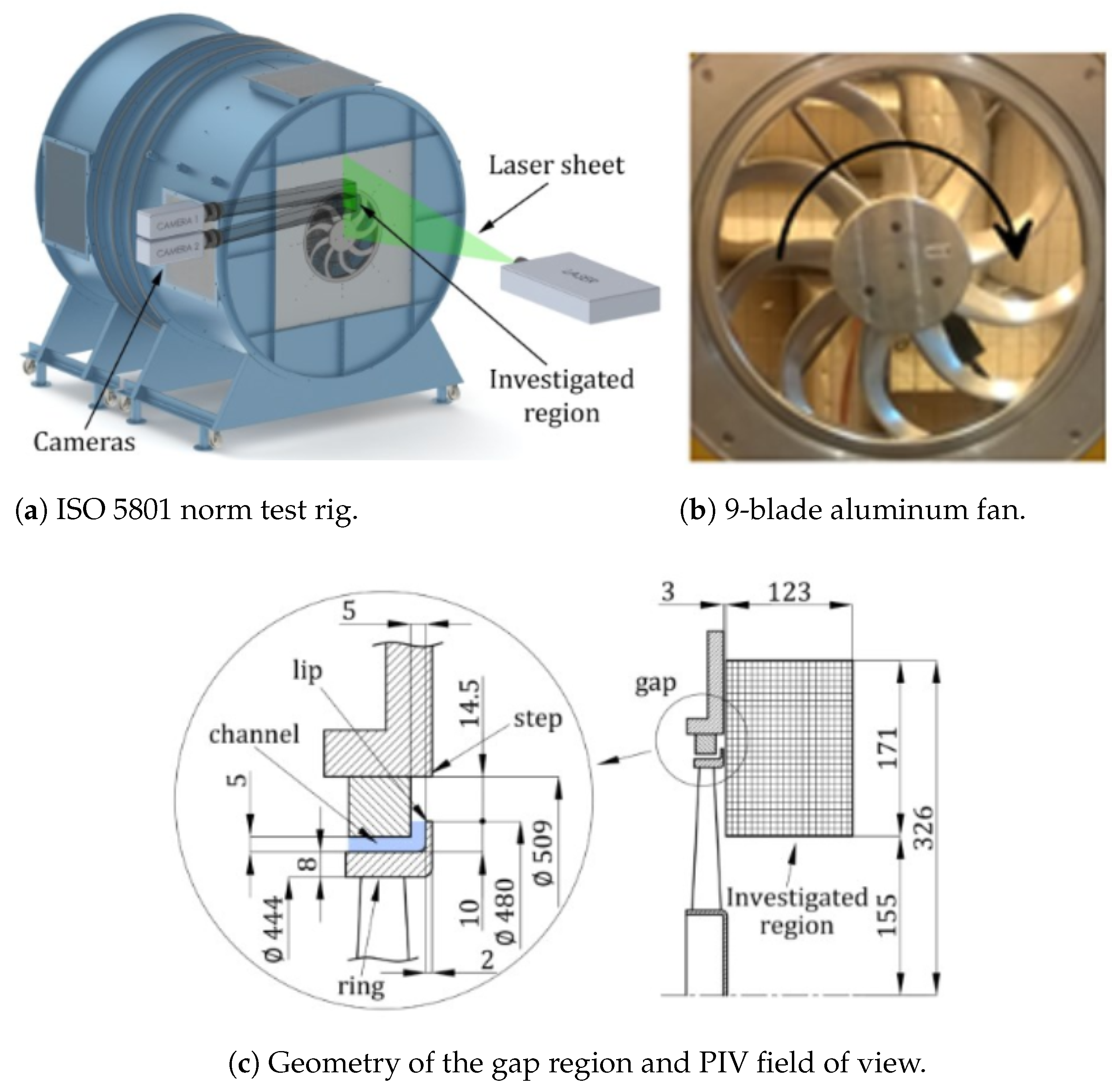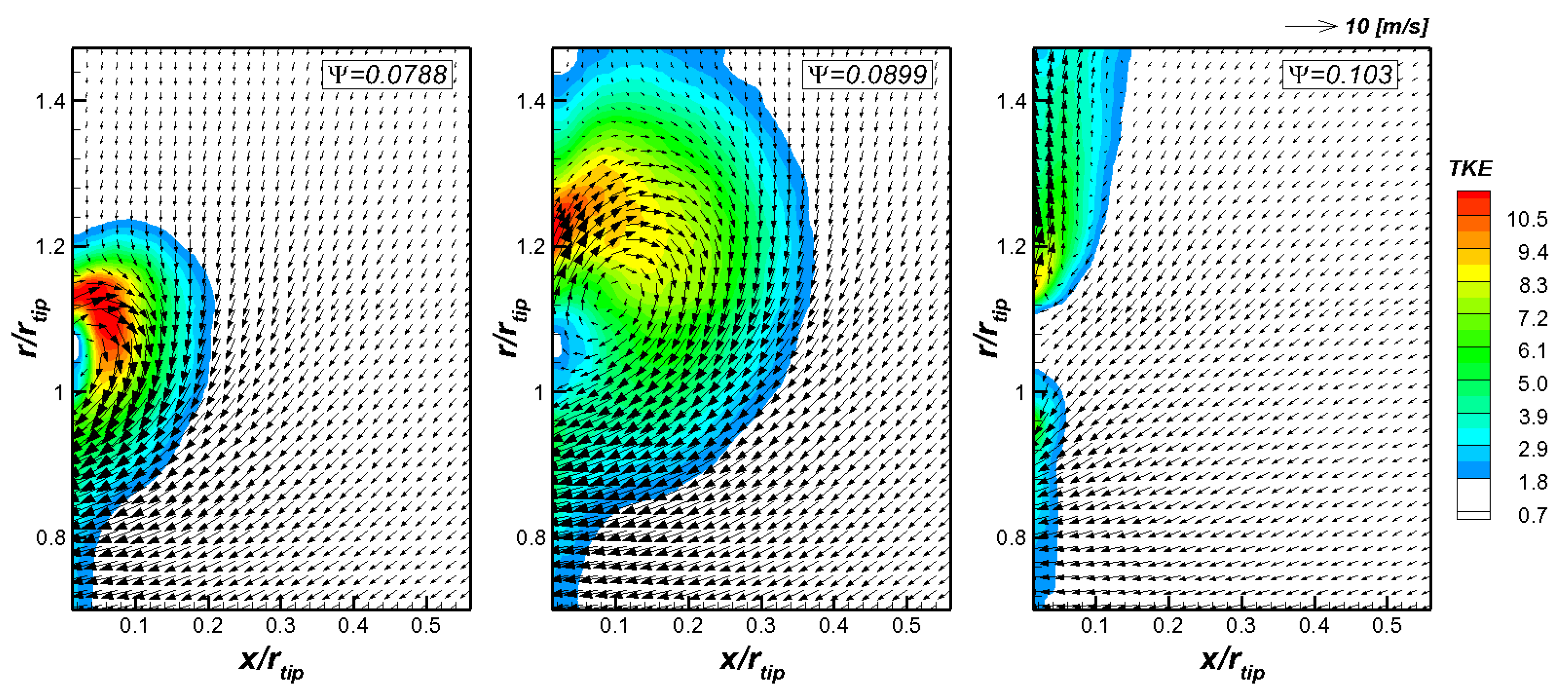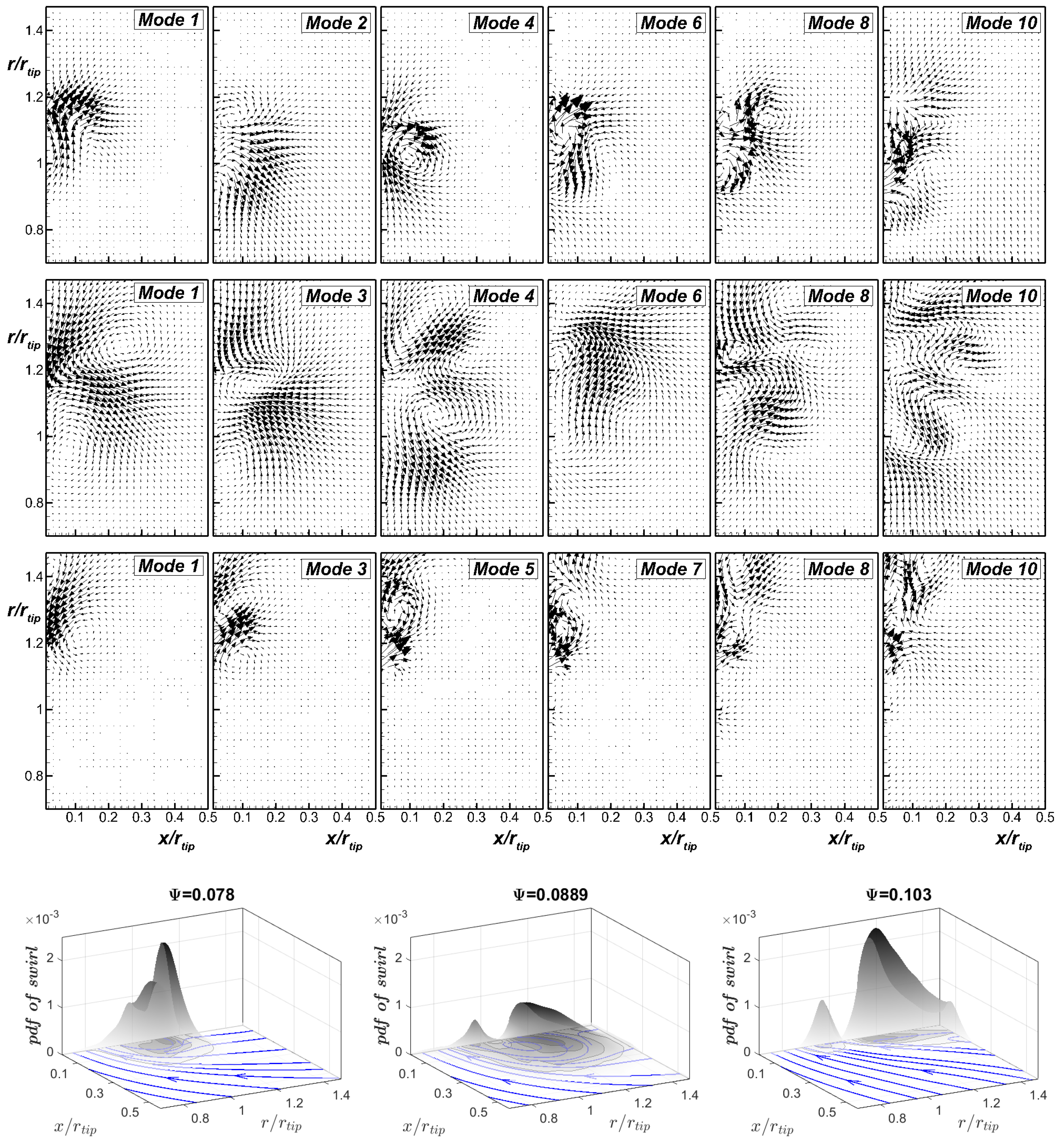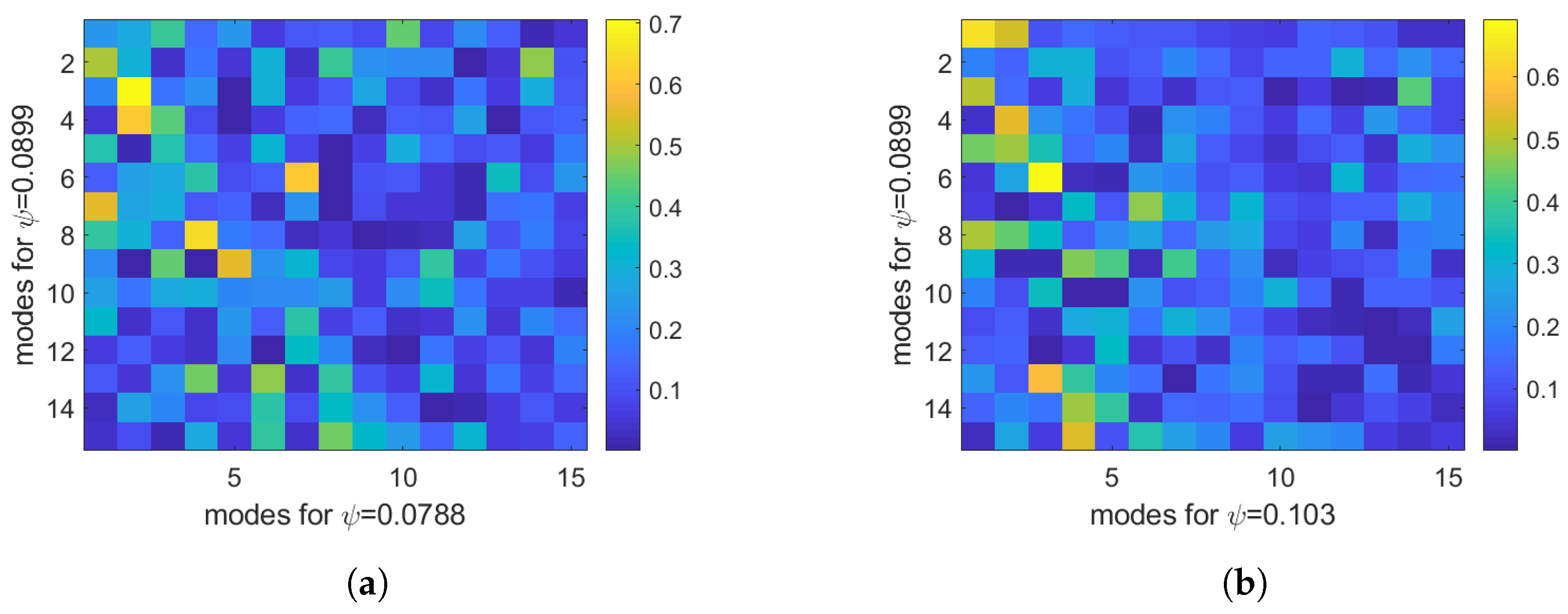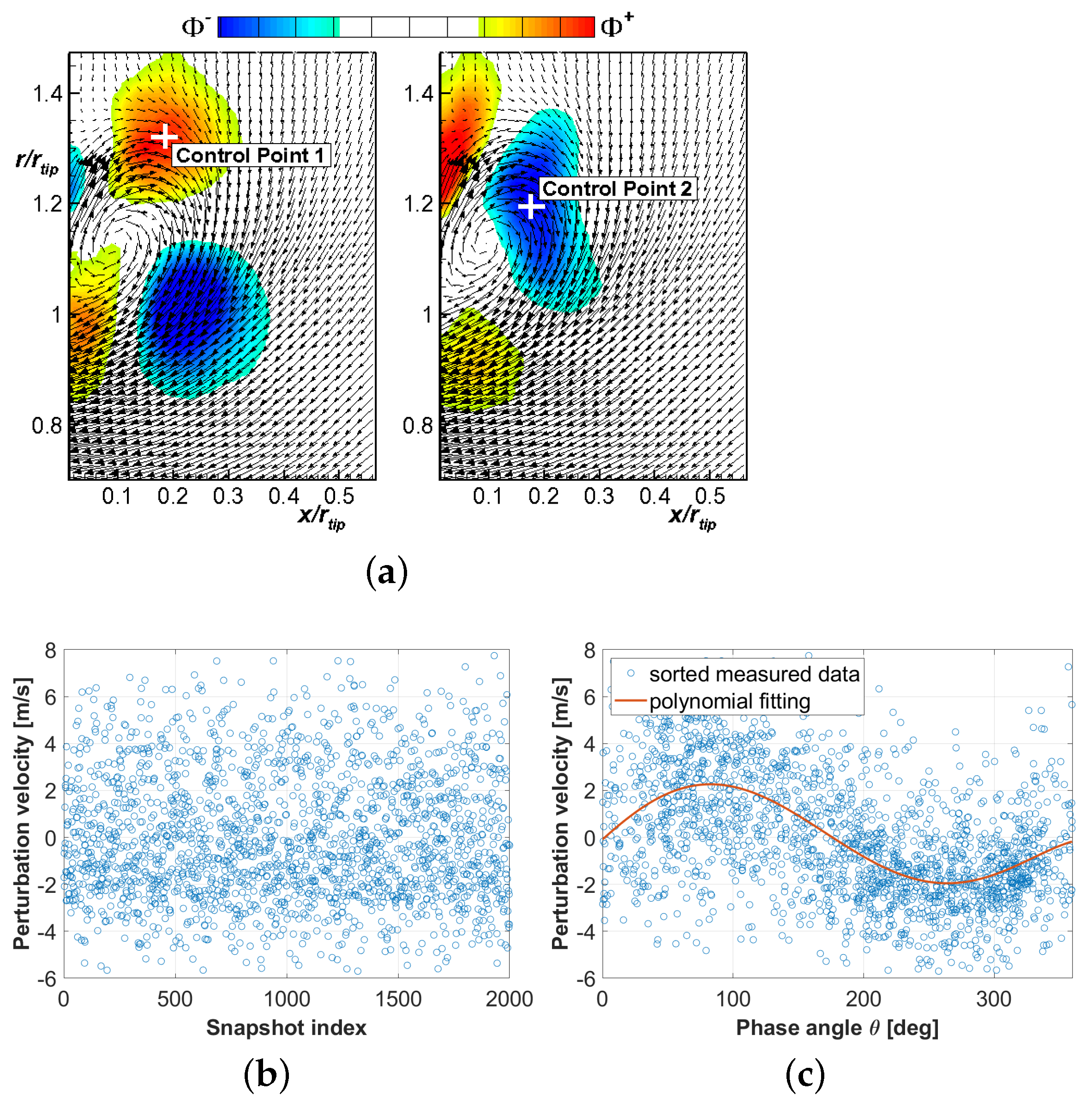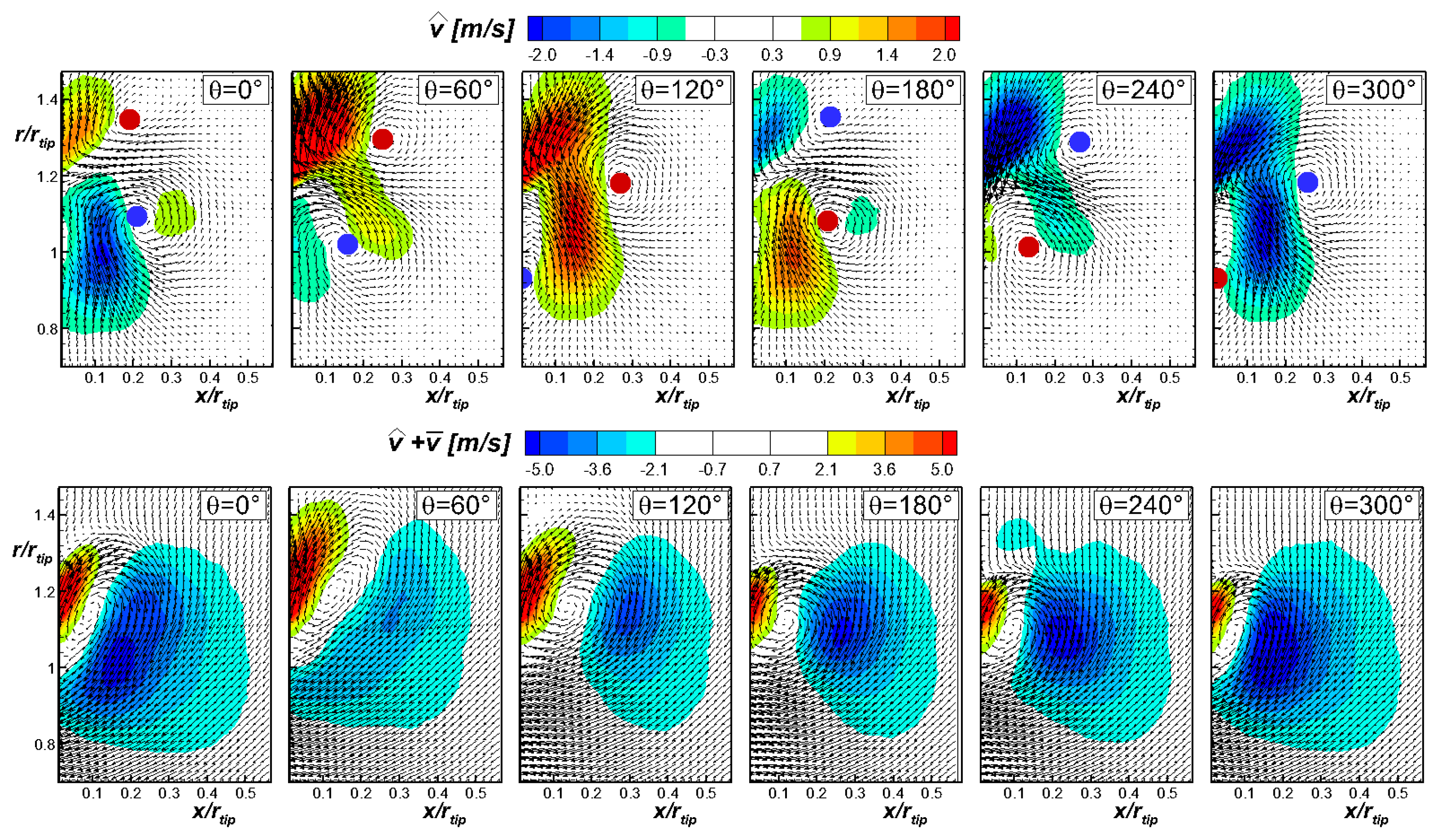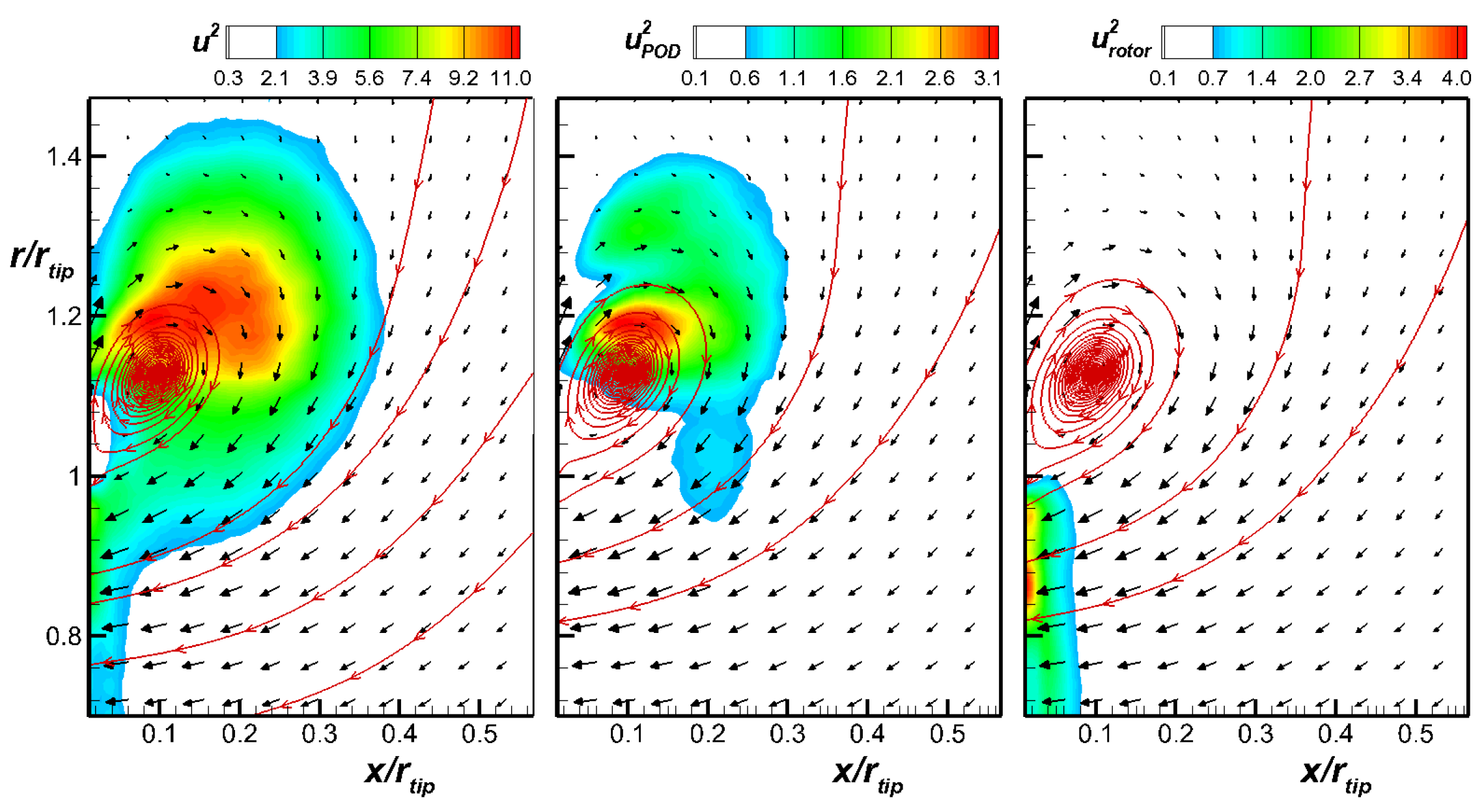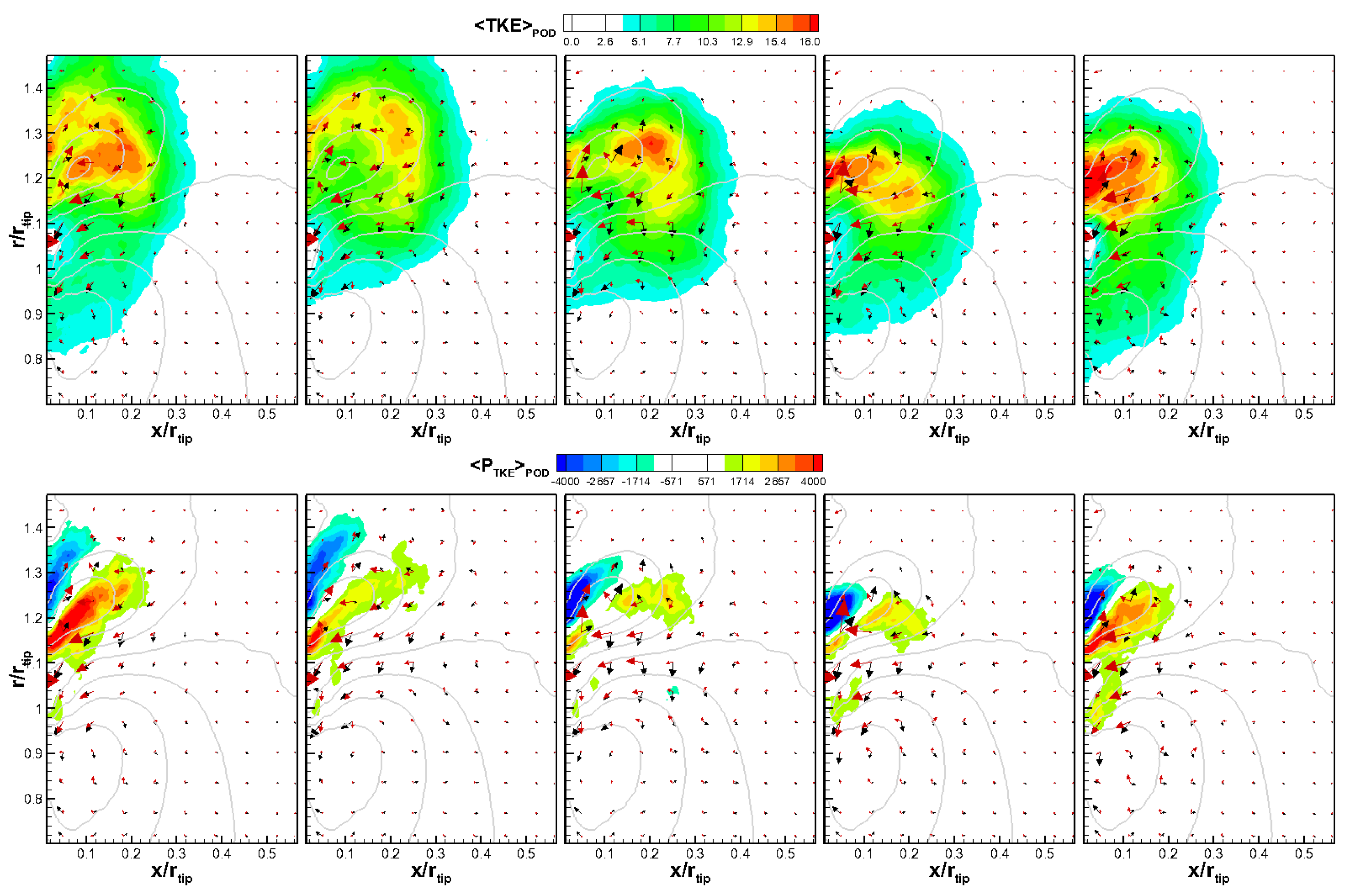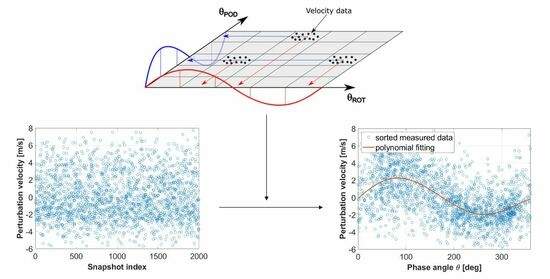4.1. POD Mathematical Framework
The proper orthogonal decomposition was proposed first by Lumley [
17] for the analysis of turbulent flows. Given a certain velocity field (i.e.,
), the POD procedure provides spatial modes
(resembling the flow structures) and temporal coefficients
(retaining the mode dynamics). According to the original formulation of Lumley [
17], POD modes are computed as the eigenvectors of the spatial cross-correlation tensor of flow samples. In the present work, the successive formulation of Sirovich [
18] has been adopted, in which the POD coefficients are directly obtained as the eigenvectors of the temporal cross-correlation matrix
C:
where
,
U is the snapshot matrix containing the instantaneous realizations of the field,
X is the matrix containing the eigenvectors of
C, and
is a diagonal matrix with the sorted eigenvalues. Once the POD temporal coefficients are computed from Equation (
1), the corresponding spatial modes are obtained by projection as
where
Z is the matrix containing the POD modes
normalized with their corresponding eigenvalues. POD can be also used to construct reduced order models providing a filtered snapshot matrix
that retains the contribution of the first
K modes only. This is done by inverting Equation (
2):
where the last
columns of
Z are set to zero.
Once the POD modes have been computed, a POD-based phase averaging technique has been applied, where the reference signal is directly extracted from the leading modes (see Lengani et al. [
16]). Particularly, if periodic convective structures occur within the flow, coupled modes are typically observed, i.e., modes with similar energy content and spatial distribution (see Legrand et al. [
19]). Therefore, the corresponding low-order models can be used to sort the instantaneous snapshots based on the main period highlighted by the modes. According to Equation (
3), the contribution of the
kth POD mode to the
ith PIV snapshot can be written as
where
is the
ith element of the
kth POD coefficient. Then, if the
kth and the
th modes are coupled and representative of the same convective structures, the phase angle
of the
ith record is defined as
where
and
are control points used for the computation of each snapshot phase. According to the above-mentioned method, all snapshots may be sorted based on their corresponding phase angle, and a POD-based phase averaged velocity field can be computed. Since this work aims at the characterization of the radial motions involving the leakage flow, the POD modes of the radial velocity component are taken as reference for the present POD analysis. This latter has been carried out considering the quota of the fluctuating velocity field, which is not affected by the rotor position. Namely, the periodic components obtained from the rotor-based phase averaging procedure have been removed from the original snapshots before applying the POD procedure. This has been done because the rotor-based phase-averaged field, not shown here for brevity, did not show any radial oscillations of the flow leaving the gap; see Canepa et al. [
13].
4.2. POD Analysis of Rotor-Unrelated Fluctuations
The dominant coherent motions that are not related to the rotor position are studied in this section by means of the Proper Orthogonal Decomposition.
Figure 3 depicts the percentage energy of the first 20 POD modes obtained from the POD total kernel (i.e., filling the matrix
U with both
u and
v,
-modes) and from the radial velocity only (
-modes). For the cases
and 0.0899, the first mode of the total kernel captures more than 16% of the overall energy of fluctuations, while for
, the leading mode energy is significantly smaller. This indicates that for the cases
and 0.0899, the rotor-unrelated fluctuations are dominated by few large coherent patterns, which capture a higher quota of the turbulent kinetic energy compared to the case
. Similar considerations still hold for the POD modes of the radial velocity component. Interestingly, modes 3 and 4 of
v show a similar energy content for the case
(
Figure 3b), contrary to the other cases. As discussed in the following, these modes are representative of the same coherent structures, and they are referred to for the analysis of the unsteady behavior characterizing the leakage flow for this operating condition.
Figure 4 shows exemplary modes of the total kernel for the three values of
here considered. These modes have been chosen among the first 10 to highlight the main coherent patterns within the rotor-unrelated fluctuating velocity field. Modes among the first 10 showing similar patterns to those depicted in
Figure 4 are not reported here for the sake of brevity. Additionally, the mode index strictly depends on the analysed flow case.
Beside the dominant POD modes, the probability density function (
) of the occurrence of vortical structures is shown for each case in the form of gray surfaces (bottom plots). Such
distributions have been obtained by means of a wavelet-based vortex identification technique (see Simoni et al. [
20]) applied to the overall fluctuating velocity field, i.e., retaining also the rotor-related unsteadiness, in contrast to what has been done for the computation of the modes. Therefore, the comparison between the
and the POD mode distributions provides information about the spatial location of vortical structures that are or are not related to the rotor position. Particularly, one may clearly see that a dominant
peak occurs for all cases at the spatial positions where large-scale coherent structures are highlighted by the modes. Most of the vortical events observed in the present measuring plane are therefore not necessarily linked to the rotor position.
For the case , the dominant POD modes resemble vortical structures near the rotor gap and the blade tip. They are representative of the coherent fluctuations of the leakage flow that, for the present case, stay attached to the rotor ring. In contrast, the POD modes for the case = 0.103 show regions of high vorticity for , while the energy of the modes is almost null in front of the rotor blades. This clearly indicates that for , the minor peak observed in the blade region (i.e., ) is substantially linked to rotor related unsteadiness.
The modes computed for the case
= 0.0899 depict coherent fluctuations covering a wider spatial region than for the other cases; vorticity cores are indeed observed in the blade region as well as above the rotor gap, thus showing similarities with the cases at the lowest and the highest
values. This is consistent with the increment of the
variance (i.e., the base area). Note that since the POD modes depicted in
Figure 4 are obtained from the rotor-unrelated unsteadiness, the captured flow patterns are not linked to the rotor position. The flow features highlighted by the modes in front of the rotor blade are therefore expected to be linked to a different source of unsteadiness causing the radial motion of the flow leaving the gap. As a consequence, the
peak observed in the blade region for
= 0.0899 is due to the superposition of both rotor-related and -unrelated coherent vortical structures. It is mentioned here that based on the inherent three-dimensionality of the instigated flow field, the cores of vorticity observed in the present measuring plane may be the trace of vorticity tubes extending in the circumferential direction, as described in the previous authors’ work Canepa et al. [
3]. Nevertheless, the radial motions involving the leakage flow for the intermediate value of the pressure rise coefficient are shown to be well captured by the present set of measurements. Further measurements are being carried out to investigate the evolution of leakage flow fluctuations in the tangential direction.
The POD modes presented in
Figure 4 highlighted existing similarities between the tested conditions. More precisely, the modes computed for the mid-pressure coefficient have been shown to partially resemble the coherent patterns highlighted by the leading modes obtained for the lowest and the highest pressure rises. This suggests that, for the intermediate pressure coefficient, the leakage flow oscillates between an attached-like (as for
) and a radial-like (similar to the case
) configuration. In order to provide a quantitative view of the existing similarities between the dominant flow features occurring for the case
= 0.0899 and for the other two operating conditions, we computed the cross-correlation matrix of the spatial POD modes obtained independently for each value of the pressure coefficient. To this end, the POD modes have been normalized so that their scalar product provides a direct measurement of mode similarity.
Figure 5a depicts the absolute value of the correlation matrix between the first 15 modes obtained for the cases
= 0.0899 and 0.0788, where modes 3 and 2, respectively, show the highest degree of correlation. On the other hand, modes 6 and 3 show the highest similarity when computing the POD correlation matrix for the cases
= 0.0899 and 0.103 (
Figure 5b). The inspection of the spatial distributions of the correlating modes highlighted here (see
Figure 4) provides evidence of the similarities between the flow cases. Mode 3 for the case
= 0.0899 depicts coherent fluctuations near the rotor gap, as in mode 2 for the case
= 0.0788. Otherwise, mode 6 is representative of vorticity nuclei that occur for
, similarly to mode 3 for the case
= 0.103. The fourth mode computed for the intermediate pressure coefficient shows instead coherent motions affecting the entire measuring plane, thus being representative of the leakage flow oscillation.
According to Equation (
4), the POD temporal coefficients retain the contribution of the corresponding modes to each of the PIV snapshots. The inspection of the coefficients 3 and 6 for the case
= 0.0899 therefore provides the statistical distribution of the acquired velocity fields between the two flow states highlighted by the corresponding modes, which were shown to resemble the most
and the most
-like conditions. In this sense, all the PIV snapshots collected for the intermediate pressure rise can be reported in a 2D plane defined by the POD coefficients
, where the
ith flow record is expressed in terms of the set of coordinates
. This is shown in
Figure 6a, where each symbol represents a different PIV snapshot in the coordinate system defined by the chosen temporal coefficients. These latter are computed by the projection of the snapshot matrix on the normalized modes; thus, their norms retain the energy of fluctuations. It is worth noticing that the snapshots acquired for the case
= 0.0899 exhibit a quasi-Gaussian distribution on both coefficients (see
Figure 6b,c). Therefore, the projection of the acquired snapshots onto the POD subspace defined by the coefficients 3 and 6 does not highlight any bi-modal distributions that may indicate the occurrence of well-defined clusters within the data associated to an intermittent flow pattern. The leakage flow is therefore expected to oscillate continuously between different states that rarely reach a pure radial and attached-like configuration. In the following section, the POD procedure presented in
Section 4.1 is used to shed light on the coherent motions driving the radial fluctuations of the flow leaving the gap.
4.3. Characterization of the Leakage Flow Dynamics for the Case = 0.0899
In order to investigate the oscillating behavior of the leakage flow for the case
, the modes of
v are further processed in this section. Particularly, modes 3 and 4 have been shown to be coupled in terms of their energy content (see the right plot of
Figure 3, squared symbols) and their spatial distributions, which are reported in
Figure 7a, are similar but shifted in the mean flow direction. According to Legrand et al. [
19], these modes are therefore representative of the same periodic convective structures and can be used for the computation of a POD-based phase averaged velocity field. This may highlight the existing link between the periodic patterns captured by the modes and the oscillating behavior characterizing the leakage flow for
. According to Equation (
5), the phase related to each snapshot has been computed based on modes 3 and 4. To do that, two control points have been chosen in regions with the opposite sign of the modes (see the white crosses in
Figure 7a). Once the correct phase angle is assigned to each flow record, the PIV snapshots can be re-ordered, and then the corresponding phase averaged field can be computed.
Figure 7b reports the rotor-unrelated fluctuations in the radial direction probed at the control point 1. Notice that the PIV snapshots have been acquired with a sampling rate that is significantly smaller than the characteristic frequencies of the flow field; thus, the flow records are randomly positioned within the main period highlighted by the modes. Instead,
Figure 7c reports the sorted velocity values plotted versus the phase angle assigned to the corresponding snapshots. Additionally, the phase-averaged values obtained by means of a fifth-order polynomial fit to the phase-sorted velocity data are reported with a solid red line, showing a well defined periodic pattern. The present method has been applied to all measuring points to compute a POD-based phase averaged field retaining the periodic coherent motions that are not related to the rotor angular position.
The top plot of
Figure 8 reports the POD-based phase averaged fluctuating velocity field
at different phase angles, while in the bottom plot, the contribution of the time-mean velocity is also included, i.e.,
. The contour plot of
is also superimposed to the corresponding vector fields. It is mentioned here that even if the phase angle of each snapshot is computed with reference to modes 3 and 4 of the radial velocity only, the phase averaged field is computed considering all the dominant modes. The snapshots reported in the top plots of
Figure 8 depict counter rotating vortices that form near the blade tip (see the red and blue circles in the plots). These are the signatures of vorticity tubes that evolve in the tangential direction as described by Canepa et al. [
3]. Once formed, they rotate and then move towards the rotor inlet section (see the plots at
=
and
). For
, a new vortex-like structure is expected to occur outside of the measuring plane (
). Such a structure moves at lower radii leading to the flow pattern observed in the first plot (
). It is worth noting that the periodic fluctuations highlighted by the present procedure are characterized by the inversion of the radial velocity component from the largest positive values observed for
=
to the most negative ones occurring for
=
. This is further highlighted in
Figure 9, showing the velocity data probed above the blade tip at
and
. The same trend was not observed instead in the rotor-based phase-averaged field (see Canepa et al. [
3]). Interestingly, when the periodic fluctuations depicted in the top plots of
Figure 8 are added to the time-mean velocity field (bottom plots), this latter exhibits a marked vertical motion in the surrounding area of the rotor gap. The large scale vortical structure centered at about
= 1.1 for
stretches in the vertical direction, and
v again switches from negative to positive values for
1.22. The present results clearly indicate that the oscillating behavior and the mean flow deformation observed for
= 0.0889 are linked to the periodic motion of the coherent structures related to modes 3 and 4 of
v, which is independent of the rotor position. The computation of its own frequency would therefore be of great relevance. Nevertheless, it may not be directly provided from the present set of measurements due to the low sampling rate adopted. Further investigations will be carried out in a dedicated work for the detailed inspection of the frequency content of the flow patterns depicted in
Figure 8.
With the aim of inspecting the regions of the measuring plane that are mostly affected by the coherent motions embedded in the flow, the energy of the periodic fluctuations provided by the rotor-based and POD-based phase averaging procedures has been computed. The so-derived energy distributions are compared in
Figure 10 snd
Figure 11 with the energy of the overall axial and radial fluctuating velocities. The highest energy of the rotor phased field (subscript
) are found in the blade and the gap regions for both the velocity components. In contrast, the energy of the periodic motions highlighted in
Figure 8 is maximum above the rotor gap. This further highlights the role of the rotor-unrelated fluctuations in promoting the vertical motion of the leakage flow above the gap region. Moreover, the energy of the POD phased radial fluctuations are significantly larger than those phased with the rotor period. When comparing the contributions due to the periodic sources of unsteadiness with the overall energy of fluctuations, one can see that this latter is much larger compared to the others. This indicates that the unresolved unsteadiness plays a key role in the definition of the overall energy of fluctuations, especially for what concerns the radial velocity component. In the next section, the POD- and the rotor-based phase averaged fields are referred to for the computation of the phase averaged distributions of the quasi turbulent kinetic energy and its production, thus showing the effects of the different periodic source of unsteadiness on turbulence generation and transport.
4.4. Phase Averaged Distributions of Quasi Turbulent Kinetic Energy and Its Production
This section reports the phase-averaged TKE distributions based on the blade period and the periodic motion extracted by the modes. Additionally, the TKE production has been computed based on phase averaged quantities (see e.g., Michelassi and Wissink [
21]):
where
denotes phase dependent quantities,
is the turbulent velocity field, and
is the phase averaged one. The stress terms appearing in Equation (
6) have been computed from the non-periodic unsteadiness, which has been obtained by subtracting the rotor- and POD-based phase averaged fields from the overall fluctuating velocity. Then, the measured data have been sorted based on the corresponding phase index of the two periodic patterns and then combined with the strain tensor accounting for the deformation of the mean and phase dependent fields.
Figure 12 shows the contour plots of the rotor-based phase-averaged turbulent kinetic energy (
) and its related production (
). Plots are shown at the phase angles
and
. Additionally, the gradient vectors of
and
are depicted with black and red color, respectively, to highlight the regions of high strain. Interestingly, both
and
show negligible variations with the phase angle; thus, the turbulent kinetic energy and its production do not depend on the rotor phase. Moreover, the maximum of both quantities is observed in the gap region where the largest gradients of the phase-averaged field occur. Turbulence production is therefore given by the combination of high levels of phase dependent strain with turbulent stresses. It is worth noting that both positive and negative values of
are observed for all phase angles. The occurrence of negative
indicates energy back transfer from the unresolved unsteady field to the corresponding phase-averaged one. However, the integral value of
is positive, thus leading to the increment of the overall turbulence level within the flow field.
A completely different scenario characterizes the POD-based phase averaged TKE (
) and related production (
), see
Figure 13. The
distribution shows high dependence on the phase angle in terms of its maximum values and their spatial positions. The highest values of
always occur for
, while lower ones are observed in front of the blade. Additionally, the region of maximum TKE moves at different radii within the reference period. This behavior well resembles the one observed in the phase-averaged field reported in
Figure 8. This indicates that the periodic pattern highlighted by the POD analysis may cause turbulence transport at different radial locations. Since the interaction between the flow unsteadiness generated by the leakage flow and the rotor may produce different noise levels depending on the region where interaction occurs, the capability of the currently adopted procedure in highlighting turbulence transport due to coherent motions within the flow might be useful for the acoustic optimization of the aerodynamic component tested here. Interestingly, negative values of
dominate; thus, the periodic motion captured by the POD modes is mostly responsible for energy back transfer from the unresolved to the POD-based phased-averaged velocity field. This behavior is different from what has been found based on the rotor-based phase averaging procedure.
